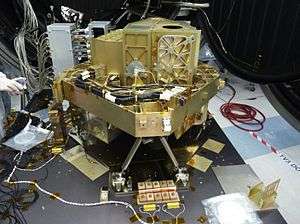Begoña Vila
María Begoña Vila Costas (born 1963) is a Spanish astrophysicist specializing in the study of spiral galaxies. She currently resides in Washington, D.C. and works as a systems engineer at the Goddard Space Flight Center's Planetary Geology, Geophysics, and Geochemistry Laboratory.[1] She is the lead engineer for the Fine Guidance Sensor and Near Infrared Imager and Slitless Spectrograph (FGS-NIRISS) on the James Webb Space Telescope – the Hubble's successor – in addition to being in charge of the final cold test of the group of instruments before their integration with the telescope.
Begoña Vila | |
|---|---|
.jpg) | |
| Born | María Begoña Vila Costas 1963 (age 56–57) Vigo, Spain |
| Alma mater | University of Manchester |
| Occupation | Astrophysicist, systems engineer |
| Employer | NASA |
| Awards |
|
Career
Begoña Vila studied Astrophysics at the University of Santiago de Compostela and the Canary Islands Institute of Astrophysics from 1981 to 1986. She received her doctorate in Astrophysics at the Jodrell Bank Centre for Astrophysics at the University of Manchester in 1989.[2]
Beginning in 2006 she worked on the design and construction of the Fine Guidance Sensor and Near Infrared Imager and Slitless Spectrograph (FGS-NIRISS) that will be carried by the James Webb Space Telescope at a Canadian company under the direction of the Canadian Space Agency. When it was delivered in 2012 and the first cold test was done, NASA decided to hire her through an external company as a systems engineer for the instrument.[3]

Since 2013 she has been "FGS lead systems engineer", in charge of tests of the sensor, its operations in orbit, limitations, software components, etc. She also coordinates all the scientific instruments grouped in the Integrated Science Instrument Module (ISIM) for the cold tests.[2][3]
She is a member of Españoles Científicos en USA (ECUSA-DC), an organization that encompasses the Spanish scientific community in Maryland, Virginia, and Washington, D.C.[4]
In 2016, she was honored by NASA with the Exceptional Public Achievement Medal for her "years of outstanding leadership and achievement", as well as the design and development of the FGS-NIRISS.[3][5]
In 2017 she won the María Josefa Wonenburger Planells Award for her scientific work.[6]
References
- Palca, Joe (28 November 2016). "Some Assembly Required: New Space Telescope Will Take Shape After Launch". KPBS Public Media. Retrieved 25 May 2019.
- Sacristán, Enrique (22 August 2016). "La NASA premia a una astrofísica gallega por su trabajo en el mayor telescopio espacial" [NASA Awards a Galician Astrophysicist for Her Work on the Largest Space Telescope]. El Confidencial (in Spanish). Retrieved 25 May 2019.
- "NASA gives recognition to the work of Spanish astrophysicist Begoña Vila". España Global. September 13, 2016. Retrieved May 25, 2019.
- "Washington DC" (in Spanish). Españoles Científicos en USA. Retrieved 25 May 2019.
- "La astrofísica viguesa premiada por la NASA, Begoña Vila, visita 'A Revista'" [The Astrophysicist from Vigo Awarded by NASA, Begoña Vila, visits 'A Revista']. Faro de Vigo (in Spanish). Vigo. 26 August 2016. Retrieved 25 May 2019.
- "La astrofísica viguesa Begoña Vila gana el premio Wonenburger" [The Astrophysicist from Vigo, Begoña Vila, Wins the Wonenburger Award]. La Voz de Galicia (in Spanish). Santiago de Compostela. 28 October 2017. Retrieved 25 May 2019.
External links
- Begoña Vila at NASA